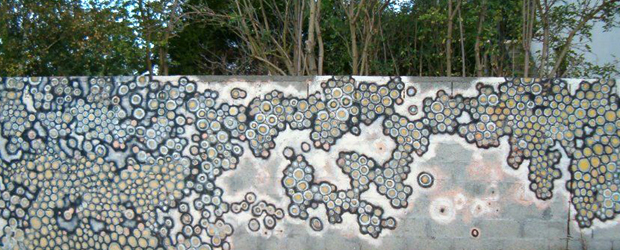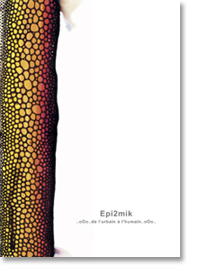Looking at the same landscape over long periods of time can cause the vision to blur, skim, or otherwise shift to an engagement based more on habit than curiosity. This sometimes becomes the case in my research on graffiti or street art. It is easy to tell a reliable narrative about an art object through the frame of the already-having-been seen.
Of course, as many theorists of the aesthetic and political can tell us, such an approach has clear drawbacks. Luce Irigary argues that one ought to approach gender as not a given but a space of wonder that "sees as if always for the first time." In French, the word for gender and genre is one and the same genre. Socially produced identity can relate to questions of gender, but also simply genre, belonging to a certain category. In either case, the stakes for membership are often high. This week, from March 25, 2014 to March 30, 2014, there was a large scale exposition on drawing. I attended on the suggestion of Nathalie Victoire, a street artist, who told me that there were works by one of France's first street artists: Speedy Graphito. Visiting Drawing Now has helped me to reconsider, or rather, reminded me, that the question of aesthetic genre, membership, identity, and history for street art/graffiti, is very much up for grabs and lies neither on the side of painting nor drawing.
 |
| Speedy Graphito. Salon du dessin. March 30, 2014. Photo Credit: Caitlin Bruce |
 |
| Speedy Graphito. Salon du dessin. March 30, 2014. Photo Credit: Caitlin Bruce |
There is also a piece from Swoon's "Motherlands" show, and Bodelocque did a live drawing of one of his animals on chalkboard. Indeed, Le Monde reports, "l'art brut," or self-taught or outsider (ish) art has a privileged place in this year's expositon.
 |
| Swoon. Motherlands. 2013. Salon du dessin. March 30, 2014. Photo Credit: Caitlin Bruce |
Jacques Villeglé, now 87 years old, is one of the major figures of New Realism and who in the 1960s, explored Paris' walls, inscribing signs and symbols to create what he describes as a "sociopolitical" alphabet." Philippe Piguet, curator of the Villeglé, Lek and Sowat show argued:
« Le dessin est très prospectif, il donne à réfléchir sur nos codes, nos sociétés (…). Il investit la ville, il est omniprésent dans les graffitis et le street art, il créé un langage ... C’est [Villeglé] une figure tutélaire de l’art urbain, Lorsque j’ai découvert ce que faisaient les jeunes graffeurs au sous-sol du Palais de Tokyo, j’ai pensé que ce serait bien d’organiser une confrontation entre eux ».
Drawing is very prospective and enables us to reflect on our codes, and our society. It invests the city, and is omnipresent in graffiti and street art, it creates a language. Villeglé is a tutelary figure for urban art. When I discovered the work of young graffiti artists [Lek and Sowat] underneath the Palais de Tokyo, I thought that it would be good to organize a confrontation between them.
 |
| Sébastian Preschoux, Lek et Sowat. Peinture acrylique, encre, scotch, et bois sur linoleum. 2014. Le Salon du dessin. March 30, 2014. Photo Credit: Caitlin Bruce |
However, it is not only the explicitly "street art" works that create more context for the movement. The exhibit as a whole functions as a reminder that drawing is the zero level of visual expression. The doodle, the scribble, the cut paper, and even an ink and paint production occupies a strange territory that is intimate, fragile, and hard to define. Different pieces in the exhibit explore and push the limits of what constitutes "drawing," from a three dimensional medicine-person caravan pulled by cigarette smoking dogs, to raw scribbles on notebook paper, to "digital drawing," the genre boundaries of drawing as an act that might be aligned with particular media are unravelled.
Le Gun, a collaborative piece, is a to-scale reproduction of a carriage, colored in black and white, containing labeled vials and objects invoking nostalgia for medicine wagons. A corpse rests on the floor of the vehicle, which is pulled by life-sized dogs.
 |
| Le Gun. Collaborative Piece. 2014. Le Salon du dessin. March 30, 2014. Photo Credit: Caitlin Bruce |
 |
| Le Gun. Collaborative Piece. 2014. Le Salon du dessin. March 30, 2014. Photo Credit: Caitlin Bruce |
 |
| Gideon Kiefer. The End of Dreams Drawings. Sense of Urgency. 2014. Le Salon de Dessin March 30, 2014. Paris, France. Photo Credit: Caitlin Bruce |
Shine Shivan's work, which largely explores themes of identity, sexuality, and mortality, offers a glimpse into the way that drawings can create a sense of heaviness and vertiginous pull.
Notably, Phallic Phobia, the Bendana Ipinel Art Contemporain gallery owner told me, was painted using poison extracted from a cactus, and carefully applied to paper over the course of two months.
 |
| Shine Shivan. Phallic Phobia, 2013. Poison sur papier. 213 x 141 cm. Salon de Dessin, Paris, France. March 30, 2014. Photo Credit: Caitlin Bruce |
 |
| Shine Shivan. Phallic Phobia close up, 2013. Poison sur papier. 213 x 141 cm. Salon de Dessin, Paris, France. March 30, 2014. Photo Credit: Caitlin Bruce |
Boudelocque's live-action drawing of a horse, part of his cosmic creatures series, demonstrated the conciousness of drawing's public character held within the exhibit (videos of the artist were also projected on the surface of the exterior of the building on Friday night, creating a connective tissue between his works on the street, and inside).
 |
| Boudelocque. Drawing from lecture. March 2014 Le Salon du Dessin. Paris, France. Photo Credit: Caitlin Bruce |
 |
| Wim Hardeman and Onno Schilstra. Panopticon Berlin. 2014. Le Salon du dessin. March 30, 2014. Photo Credit: Caitlin Bruce |
 |
| Wim Hardeman and Onno Schilstra. Panopticon Berlin. 2014. Le Salon du dessin. March 30, 2014. Photo Credit: Caitlin Bruce |
The notion of the human is further stretched by Yoshio Kitayama, whose series which invokes medieval era paintings of hellfire and damnation, yet, titled with normatively valued terms like "Human Rights," brings a sense of discomfort and the uncanny to usually valorized terms.
 |
| Yoshio Kitayama. Human Rights. 2010. Ink on toriknokoshi paper. Le Salon du Dessin. Paris, France. March 30, 2014. Photo Credit: Caitlin Bruce |
 |
| Detail. Catherine Boch. Sans Titre, 2013. |
Finally, I want to close by mentioning two pieces that point to the relationship between documentation, memory, and violence.
Johann Rivat's Uncivilized series shows protest images that largely position figures of order-- police-- as figures of barbarity, the force of the uncivilized. In moments that may precede violence acts the spectator is filled with anticipation, and left to work out how violence unfolds from neatly queued bodies.
 |
| Johann Rivat. Uncivilized. Le Salon du dessin. Espace Commines. March 30, 2014. Photo Credit: Caitlin Bruce |
Jorge Pineda's La Forêt Mensonges, The Forest of Lies, offers a disturbing tableau of a child-sized doll whose face is attached to a wall, from which heavy dark swirls unfold, gaining size and density. This forest of lies can stem from the imagination, from memory, or from the very visual field of the exposition itself. The juxtaposition between the three-dimensional life-like doll and the two dimensional scribbles is deeply disconcerting, implying the risk of the three dimensional collapsing, or the two dimensional taking on violent, tornado-like life. It presents drawing as a dynamic, emotional field that equally has the power to create, and to destroy.
 |
| Jorge Pineda. La Forêt Mensonges. The Forest of Lies. 2006/2014. Installation poupée et crayon sur mur. Le Salon du dessin. Espace Commines. March 30, 2014. Photo Credit: Caitlin Bruce |
In all cases, the exhibit forces the spectator to reconsider drawing as a genre, seeing it "for the very first time" as a technique of creation, expression, and exploration that is both fragile and powerfully persistent. It can, and is, everywhere. On our streets, in the corner of notebooks, on napkins. A viral force, the drawn proliferate without interruption. As a result, it helps me to reconsider the life of street and graffiti art, to think about it not just as painting, but a work of drawing that is tactile, embodied, and unpredictable.
























